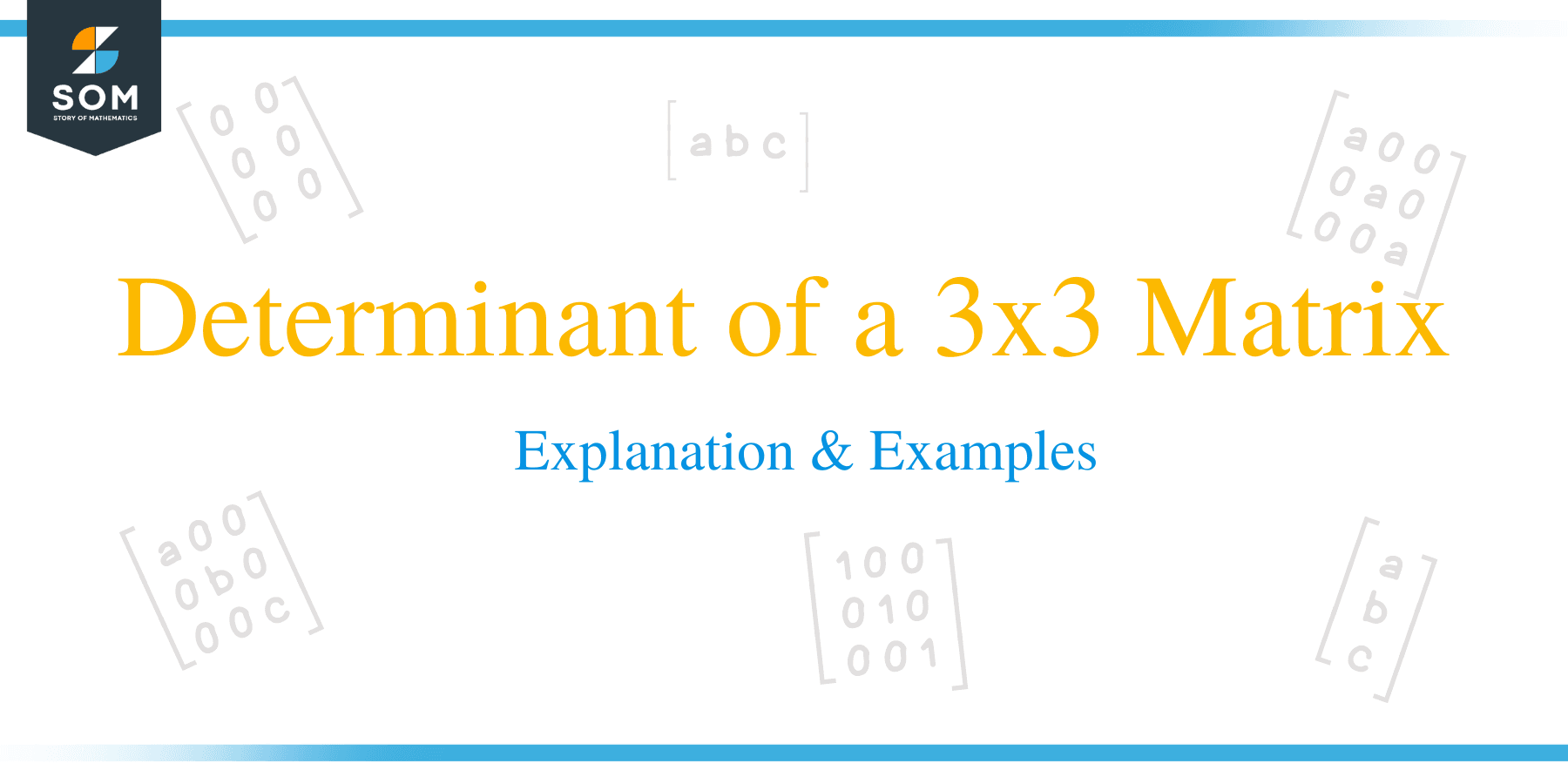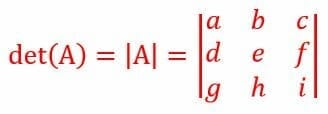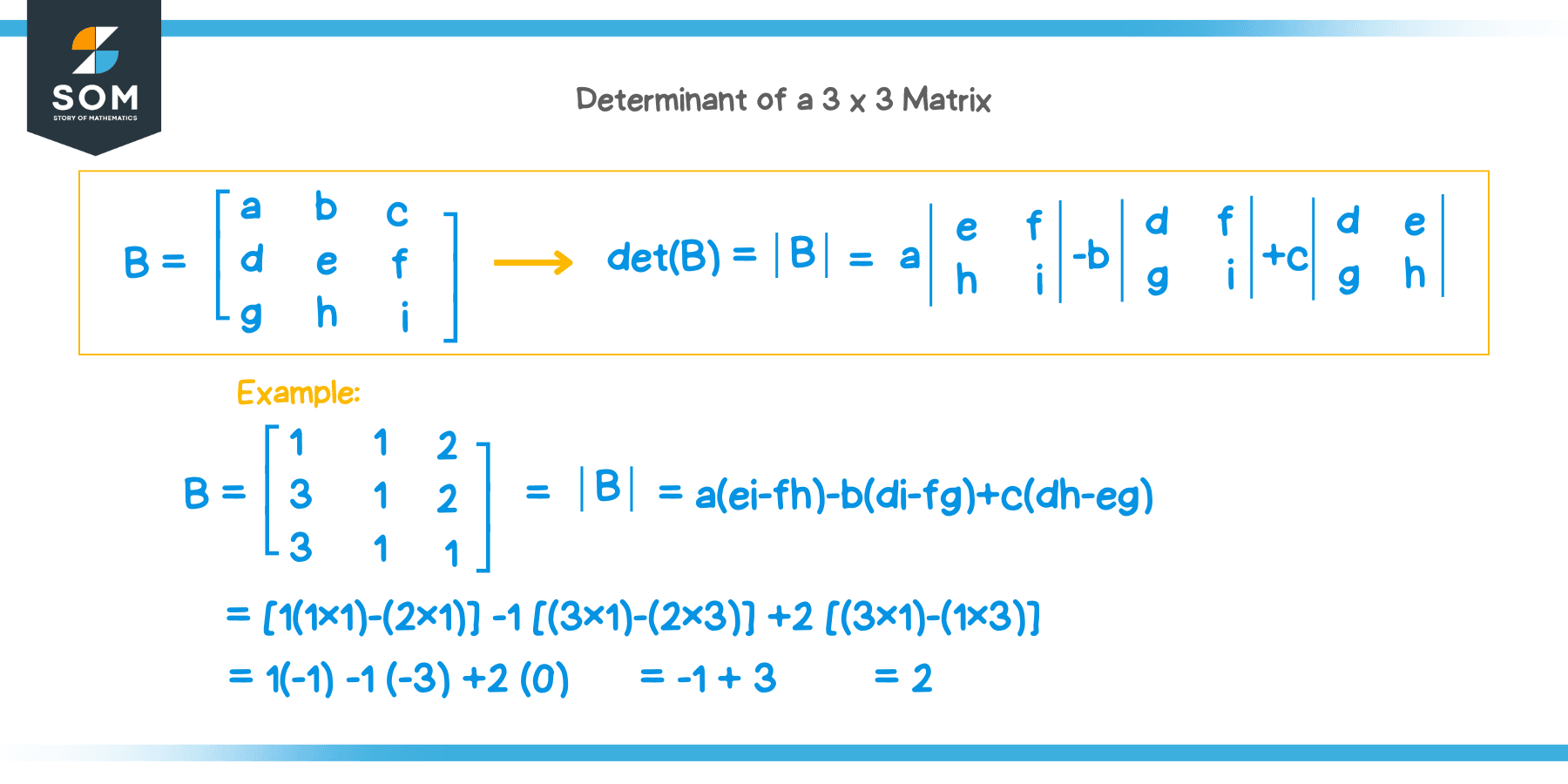- Home
- >
- Determinant of a 3×3 matrix – Explanation & Examples
JUMP TO TOPIC
Determinant of a 3 x 3 Matrix – Explanation & Examples
 The determinant is a scalar value that results from certain operations with the elements of a matrix. With the help of matrix determinants, we can solve a linear system of equations and find the inverse of matrices if it exists.
The determinant is a scalar value that results from certain operations with the elements of a matrix. With the help of matrix determinants, we can solve a linear system of equations and find the inverse of matrices if it exists.
The determinant of a 3 x 3 matrix is a scalar value that we get from breaking apart the matrix into smaller 2 x 2 matrices and doing certain operations with the elements of the original matrix.
In this lesson, we will look at the formula for a $ 3 \times 3 $ matrix and how to find the determinant of a $ 3 \times 3 $ matrix. We will look at several examples and give you a few practice problems as well.
Let’s start.
What is the Determinant of a Matrix?
Recall that a matrix’s determinant is a scalar value that results from certain operations done on the matrix. We can denote the determinant of a matrix in $ 3 $ ways.
Consider the $ 3 \times 3 $ matrix shown below:
$ A = \begin{bmatrix} { a } & { b } & c \\ { d } & { e } & f \\ g & h & i \end {bmatrix} $
We can denote its determinant in the following $ 3 $ ways:

Note: we can use the notations interchangeably.
How to find the Determinant of a 3 x 3 Matrix
First of all, we can only calculate the determinant for square matrices! There aren’t any determinants for non-square matrices.
There is a formula (specifically, an algorithm) to find the determinant of any square matrices. But that is out of the scope of this lesson, and we won’t be looking at it here. We have already taken a look at the determinant formula for a $ 2 \times 2 $ matrix, the simplest one. If you need a revision of that, please click here.
Below, we look at the formula for the determinant of a $ 3 \times 3 $ matrix and show several examples of finding the determinant of a $ 3 \times 3 $ matrix.
Determinant of a 3 x 3 Matrix Formula
Consider the $ 3 \times 3 $ matrix shown below:
$ A = \begin{bmatrix} { a } & { b } & c \\ { d } & { e } & f \\ g & h & i \end {bmatrix} $
The formula for the determinant of a $ 3 \times 3 $ matrix is shown below:
$ det( A ) = | A | = \begin{vmatrix} { a } & { b } & c \\ { d } & { e } & f \\ g & h & i \end {vmatrix} = a \begin{vmatrix} { e } & f \\ h & i \end {vmatrix} – b \begin{vmatrix} d & f \\ g & i \end {vmatrix} + c \begin{vmatrix} d & e \\ g & h \end {vmatrix} $
Note that we have broken down the $3\times 3$ matrix into smaller $2\times 2$ matrices. The vertical bars outside the $ 2 \times 2 $ matrices indicate that we have to take the determinant. From knowledge of determinant of $ 2 \times 2 $ matrices, we can further simplify the formula to be:
$ det(A)=| A | = a(ei-fh) – b(di – fg) + c(dh-eg) $
Let’s calculate the determinant of a $3 \times 3$ matrix with the formula just learned. Consider Matrix $ B $:
$ B = \begin{bmatrix} 1 & 1 & 2 \\ 3 & 1 & 2\\ 3 & 1 & 1 \end {bmatrix} $
Using the formula, we can find the determinant to be:
$ |B| = a( ei – fh ) – b( di – fg ) + c( dh – eg ) $
$ = 1((1)(1) – (2)(1)) – 1((3)(1) – (2)(3)) + 2((3)(1) – (1)(3)) $
$ = 1(-1) – 1(-3) + 2(0) $
$ = -1 + 3 $
$ = 2 $
The determinant of matrix $ B $ is $ 2 $.
Let’s look at some examples.
Example 1
Given $ C = \begin{bmatrix} 1 & { -1 } & 0 \\ { -2 } & 1 & 1 \\ 0 & { -2 } & 4 \end {bmatrix} $, find $ | C | $.
Solution
Matrix $C$ is a $3 \times 3$ matrix. We find its determinant using the formula. Shown below:
$ |C| = a( ei – fh ) – b( di – fg ) + c( dh – eg ) $
$ = 1((1)(4) – (1)(-2)) – (-1)((-2)(4) – (1)(0)) + 0((-2)(-2) – (1)(0)) $
$ = 1(6) + 1(-8) + 0(4) $
$ = -2 $
The determinant of Matrix $C$ is $ -2 $.
Example 2
Calculate the determinant of Matrix $ F $ shown below:
$ F = \begin{bmatrix} 2 & 1 & 2 \\ 1 & 0 & 1 \\ 4 & 1 & 4 \end {bmatrix} $
Solution
We will use the formula for the determinant of a $3 \times 3 $ matrix to calculate the determinant of Matrix $ F $. Shown below:
$| F | = \begin{vmatrix} 2 & 1 & 2 \\ 1 & 0 & 1 \\ 4 & 1 & 4 \end {vmatrix} $
$ = 2((0)(4) – (1)(1)) – 1((1)(4) – (1)(4)) + 2((1)(1) – (0)(4)) $
$ = 2( – 1 ) – 1(0) + 2(1) $
$ = – 2 + 2 $
$ = 0 $
The determinant of this matrix is $ 0 $!
This is a special type of matrix. It is a non-invertible matrix and is known as a singular matrix. Check this article out to know more about singular matrices!
Example 3
Find $ m $ given $ \begin{vmatrix} { -2 } & 1 & m \\ { -1 } & 0 & { – 2 } \\ 4 & { – 2 } & 6 \end {vmatrix} = 10 $.
Solution
In this problem, we are already given the determinant and have to find an element of the matrix, $ m $. Let’s plug it into the formula and do some algebra to figure out $ m $. The process is shown below:
$ \begin{vmatrix} { – 2 } & 1 & m \\ { – 1 } & 0 & { – 2 } \\ 4 & { – 2 } & 6 \end {vmatrix} = 10 $
$ -2((0)(6) – (-2)(-2)) -1((-1)(6) – (-2)(4)) +m((-1)(-2) – (0)(4)) = 10 $
$ -2(-4) -1(2) +m(2) = 10 $
$ 8 – 2 + 2m = 10 $
$ 2m = 10 – 8 + 2 $
$ 2m = 4 $
$ m = \frac{ 4 }{ 2 } $
$ m = 2 $
The value of m is $ 2 $.
Now, it’s your turn to practice some questions!
Practice Questions
Find the determinant of the matrix shown below:
$ B = \begin{bmatrix} { – \frac{ 1 }{ 2 } } & { – \frac{ 1 }{ 6 } } & 2 \\ 3 & 0 & 1 \\ { – 10 } & { 12 } & -1 \end {bmatrix} $Find $ z $ given $ \begin{vmatrix} -2 & -1 & \frac{ 1 }{ 4 } \\ 0 & 8 & z \\ 4 & -2 & 12 \end {vmatrix} = 24 $
- Consider matrices $ A $ and $ B $ shown below:
$ A = \begin{bmatrix} 0 & 1 & x \\ 4 & { – 2 } & 6 \\ 10 & { – 1 } & { – 4 } \end {bmatrix} $
$ B = \begin{bmatrix} 1 & x & { – 1 } \\ 6 & 0 & { – 2 } \\ 8 & 20 & { – 2 } \end {bmatrix} $
If the determinant of both the matrices are equal ($ | A | = | B | $), find out the value of $ x $.
Answers
Matrix $ B $ is a $ 3 \times 3 $ square matrix. Let’s find the determinant by using the formula we learned in this lesson.
The process of finding the determinant is shown below:
$ | B | = a( ei – fh ) – b( di – fg ) + c( dh – eg ) $
$ = -\frac{ 1 }{ 2 }((0)(-1) – (1)(12)) – (-\frac{ 1 }{ 6 })((3)(-1) – (1)(-10)) + 2((3)(12) – (0)(-10)) $
$ = -\frac{ 1 }{ 2 }(-12) + \frac{ 1 }{ 6 }(7) + 2( 36 ) $
$ = 6 + \frac{ 7 }{ 6 } + 72 $
$ = 79 \frac{ 1 }{ 6 } $
Thus, $ | B | = 79 \frac{ 1 }{ 6 } $.
In this problem, we are already given the determinant and have to find an element of the matrix, $ z $. Let’s plug it into the formula and do some algebra to figure out $ z $. The process is shown below:
$ \begin{vmatrix} { – 2 } & { – 1 } & \frac{ 1 }{ 4 } \\ 0 & 8 & z \\ 4 & { – 2 } & 12 \end {vmatrix} = 24 $
$ -2((8)(12) – (z)(-2)) -(-1)((0)(12) – (z)(4)) + \frac{ 1 }{ 4 }((0)(-2) – (8)(4)) = 24 $
$ -2( 96 + 2z ) +1( – 4z ) + \frac{ 1 }{ 4 }( – 32 ) = 24 $
$ -192 – 4z – 4z – 8 = 24 $
$ -8z = 224 $
$ z = \frac{ 224 }{ – 8 } $
$ z = – 28 $
The value of z is $ – 28 $.
- Using the formula for the determinant of a $ 3 \times 3 $ matrix, we can write the expressions for the determinant of Matrix $ A $ and Matrix $ B $.
Determinant of Matrix $ A $:
$ | A | = \begin{vmatrix} 0 & 1 & x \\ 4 & -2 & 6 \\ 10 & -1 & -4 \end {vmatrix} $
$ | A | = 0((-2)(-4) – (6)(-1)) – 1((4)(-4) – (6)(10)) +x((4)(-1) – (-2)(10)) $
$ | A | = 0 -1( – 76 ) + x( 16 )$
$ | A | = 76 + 16 x $Determinant of Matrix $ B $:
$ | B | = \begin{vmatrix} 1 & x & -1 \\ 6 & 0 & -2 \\ 8 & 20 & -2 \end {vmatrix} $
$ | B | = 1((0)(-2) – (-2)(20)) – x((6)(-2) – (-2)(8)) -1((6)(20) – (0)(8)) $
$ | B | = 1(40) -x( 4 ) -1( 120 ) $
$ | B | = 40 – 4x – 120 $
$ | B | = -80 – 4x $Since both the determinants are equal, we equate both expressions and solve for $ x $. The algebraic process is shown below:
$ | A | = | B | $
$ 76 + 16 x = -80 – 4x $
$ 16x + 4x = – 80 – 76 $
$ 20x = -156 $
$ x = \frac{ -156 }{ 20 } $
$ x = – 7\frac{ 4 }{ 5 } $
The value of $ x $ is $ – 7\frac{ 4 }{ 5 } $.
